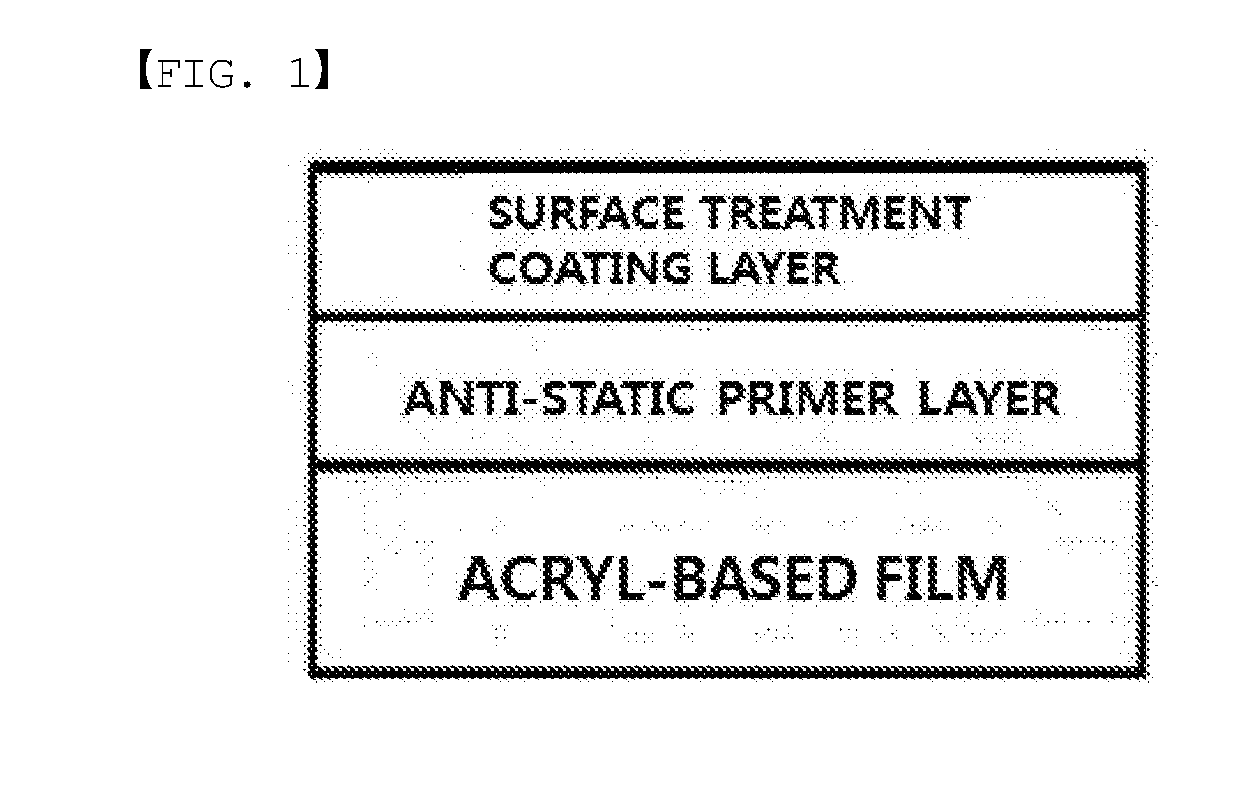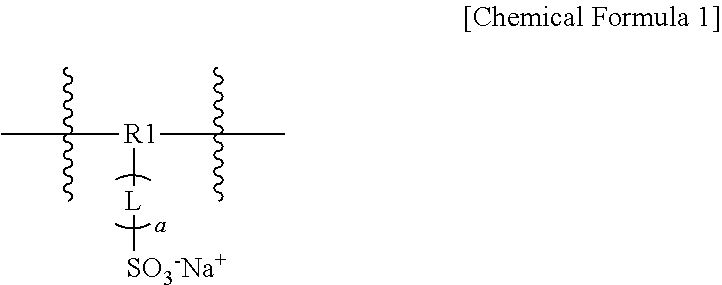Optical film having excellent antistatic property and polarizing plate comprising same
- Summary
- Abstract
- Description
- Claims
- Application Information
AI Technical Summary
Benefits of technology
Problems solved by technology
Method used
Image
Examples
synthesis example
Synthesis Example 1
Synthesis of Sulfonic Acid Polyester Resin A
[0116]A 500 ml round bottom flask was substituted with nitrogen, and ethylene glycol, diethyl glycol, sodium sulfonyl isophthalic acid and isophthalic acid were introduced thereto in a molar ratio of 0.5:0.5:0.1:0.9, and an esterification reaction was progressed for 2 hours at 200° C. to discharge a theoretical amount of water. Tetramethyl titanate, antimony acetate and t-butyltin oxide were used as a catalyst, and trimethyl phosphate was added as a stabilizer to continuously discharge water, and then a condensation polymerization reaction was carried out for 150 minutes at 255° C. under a reduced pressure of 2.5 torr or lower to prepare sulfonic acid polyester resin A. Total solid except water was 30 wt % in the resin, a glass transition temperature was approximately 60° C., and a minimum film-forming temperature was approximately 90° C.
synthesis example 2
Synthesis of Sulfonic Acid Polyester Acrylic Resin B
[0117]Glycidylethyl (meth)acrylate and methyl (meth)acrylate were introduced to the polyester resin A in a weight ratio of 40:60. The result was cooled, then a reactant and a thermal initiator were introduced thereto while stirring the result at a high speed in water, and the temperature was raised to 80° C. to prepare sulfonic acid polyester acrylic resin B for 2 hours. The weight ratio of the polyester and the acryl was 5:5, and the weight ratio of the polyester:glycidylethyl (meth)acrylate:methyl (meth)acrylate was 5:2:3. Total solid except water was 30 wt % in the resin, a glass transition temperature was approximately 60° C., and a minimum film-forming temperature was approximately 80° C.
[0118]As for the glass transition temperature, the water-dispersible resin as above was dried, then the temperature was raised to −30° C. to 150° C. using a differential scanning calorimetry (manufactured by DSC Mettler), and a glass transitio...
example
Example 1
[0119]After preparing a poly(cyclohexylmaleimide-co-methyl methacrylate) (LG MMA PMMA830HR) resin to an unoriented acryl-based film having a width of 800 mm under a condition of 250° C. and 250 rpm using a T-die film-forming apparatus, the film was oriented by 1.8 times in an MD direction at a temperature of 135° C.
[0120]19.9 g of the sulfonic acid polyester acrylic resin B of the synthesis example, 12.8 g of an anti-static material (PEDOT, solid 1.4% aqueous solution) and 67.3 g of pure water were mixed to prepare a primer coating solution. After that, the coating solution prepared above was coated on the acryl-based film oriented in an MD direction using a Mayer bar, and the result was oriented by 2.5 times in a TD direction at a temperature of 135° C. for 1 minute to prepare a film having a primer layer.
[0121]After that, an acryl-based UV curable surface treatment solution was coated on the optical film primer layer, the result was hot-air dried for 2 minutes at a temper...
PUM
| Property | Measurement | Unit |
|---|---|---|
| Percent by mass | aaaaa | aaaaa |
| Percent by mass | aaaaa | aaaaa |
| Thickness | aaaaa | aaaaa |
Abstract
Description
Claims
Application Information
 Login to View More
Login to View More - R&D
- Intellectual Property
- Life Sciences
- Materials
- Tech Scout
- Unparalleled Data Quality
- Higher Quality Content
- 60% Fewer Hallucinations
Browse by: Latest US Patents, China's latest patents, Technical Efficacy Thesaurus, Application Domain, Technology Topic, Popular Technical Reports.
© 2025 PatSnap. All rights reserved.Legal|Privacy policy|Modern Slavery Act Transparency Statement|Sitemap|About US| Contact US: help@patsnap.com



